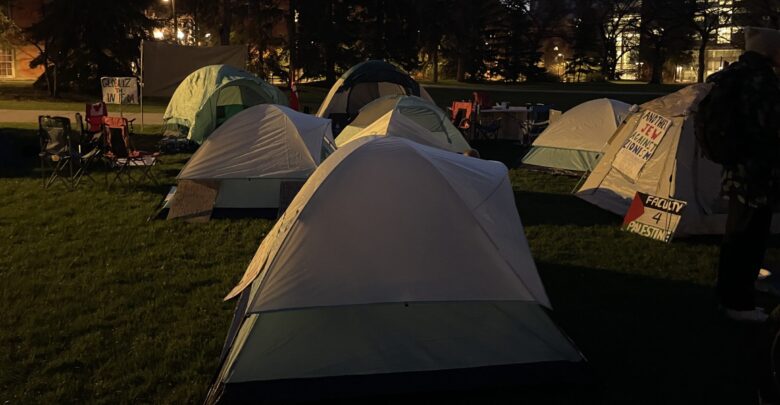EPS explains removal of Palestine solidarity encampment at U of A
Following the EPS' press conference, People's University for Palestine held a press conference at MacEwan University in response.
 Lily Polenchuk
Lily PolenchukOn May 17 at 1:00 p.m., the Edmonton Police Service (EPS) held a press conference at which they discussed the removal of the Palestine solidarity encampment from the University of Alberta Main Quad on May 11.
EPS Chief Dale McFee, who spoke first, said EPS will always protect the ability of Edmontonians to freely gather and express their views.
There is a difference between a protest and an entrenched encampment, McFee said. He added that everyone has a responsibility to ensure they’re practicing their rights in a manner that doesn’t “obstruct, intimidate, or infringe upon the rights of others, including the right to safety.”
Deputy Chief of Force says encampment occupants were given time to leave
Following McFee, Deputy Chief of the Investigation and Support Services Bureau, Devon Laforce, gave a summary of the morning of May 11.
On May 9, peace officers informed the protesters they were not welcome to camp on university grounds overnight, he said. Later, signs were posted and peace officers verbally told the protesters they were trespassing. That night, he said the camp grew to 120 people and 40 tents.
Laforce said the growing camp was a concern for the U of A, as a larger camp would “require a more dynamic and resource-heavy response that could result in the potential of more people being hurt, and certainly a greater threat to public safety.”
On May 10, the camp received a delivery of wooden pallets, Laforce said. He added that in other jurisdictions, pallets were used for barricading. According to David Kahane, a U of A professor in the department of political science, the wooden pallets were collected to put underneath tents in case of heavy rain.
The U of A requested the assistance of the EPS at 4:30 p.m. that evening. According to Laforce, EPS had intelligence that several protesters were not students. They also had information “that many students were fearful and felt intimidated by what was occurring on campus.”
At 4:35 a.m. on May 11, U of A peace officers read aloud an eviction order. When police arrived to the encampment, Laforce said there was a “frontline of occupiers that had joined their arms together in front of the police.”
At 4:55 a.m., U of A peace officers again read aloud the eviction order, this time in presence of the police. Laforce said EPS gave protesters time to leave the encampment, at which time around half of those remaining chose to leave.
Inspector says no tear gas or flashbangs were used during the dispersal
Inspector Lance Parker spoke about the removal of the encampment. During the initial clash between police and the encampment, Parker said two protesters physically resisted police. He said these protesters attempted to grab police batons and were arrested.
To prevent other protesters from interfering with the arrests, Parker said 10 to 15 pepper balls were shot into the ground, and one muzzle blast of OC powder was deployed. OC is also used in pepper spray.
“There was no liquid spray on the crowd. Certainly no tear gas. No OC grenades and no flashbangs. If you look at our officers in the video, you’ll see no shields [and] no helmets being worn and no masks,” Parker said.
As police advanced, shouting the word “move” repeatedly, Parker said they continuously gave protesters the chance to leave through many different points of exit. EPS made sure tents were unoccupied, he said. Parker also noted that the public safety unit has paramedics. Every person present was given the opportunity to receive medical attention, he said.
“None was received and there were no reports of any significant injuries to anyone there,” Parker said. Laforce added that no U of A students were arrested.
Currently, Laforce said they are seeing “continued behaviours that can be described as bullying, harassment, and intimidation.” If individuals are found to be committing criminal acts, such as doxing, criminal charges will be pursued, he said.
During question period, Laforce was asked about the doxing incidents. Laforce said the names of 11 different officers were broadcast on social media, along with address information and social media posts of individuals related to those officers.
People’s University for Palestine holds press conference after EPS’ conference
Following the press conference, media spokespeople from People’s University for Palestine YEG met with reporters at MacEwan University. People’s University for Palestine organized the encampment, and has the same demands for MacEwan University as for the U of A.
Nour Salhi said that the encampment was not a group of violent individuals.
“At no point were we a threat to any members of the U of A community, including ourselves.”
A majority of people at the encampment were U of A students, Salhi said. She said there is no way for EPS or the university to know how many present were U of A students.
Encampment occupants woke people up, not EPS, Salhi said. Some occupants were already awake for morning prayers when EPS arrived, and others were still sleeping, she said.
When they received the first trespass notice, Salhi said U of A Protective Services told them the notice was a formality and if they remained peaceful then they would not call the police.
“EPS’ constant stumbling on justifications for what they did to us does not erase the fact that they violently beat students, faculty, and community members.”
Although the People’s University for Palestine has published footage with police officers’ faces, Salhi said they have nothing to do with the names of police officers coming out.
–With files from Leah Hennig




